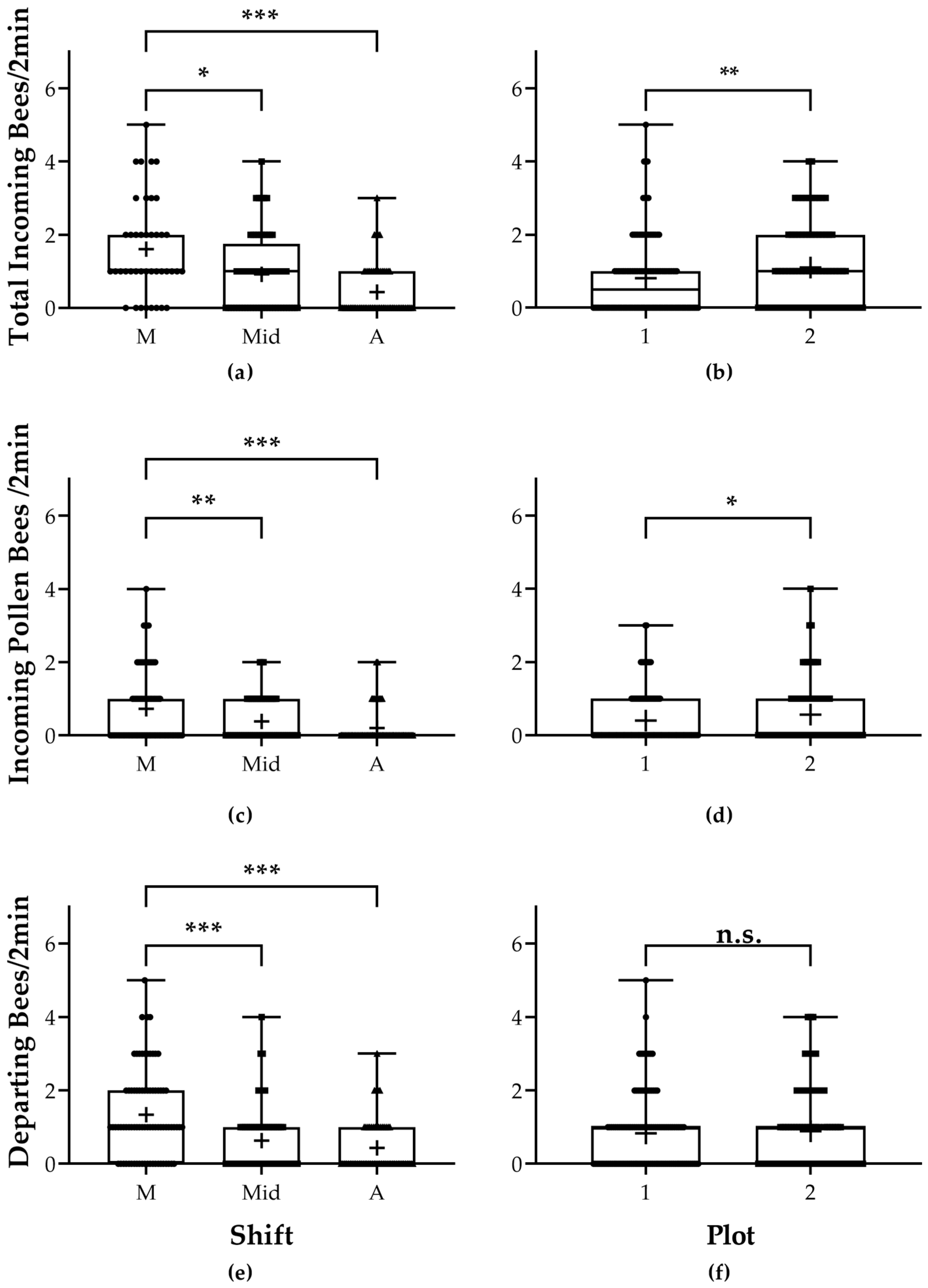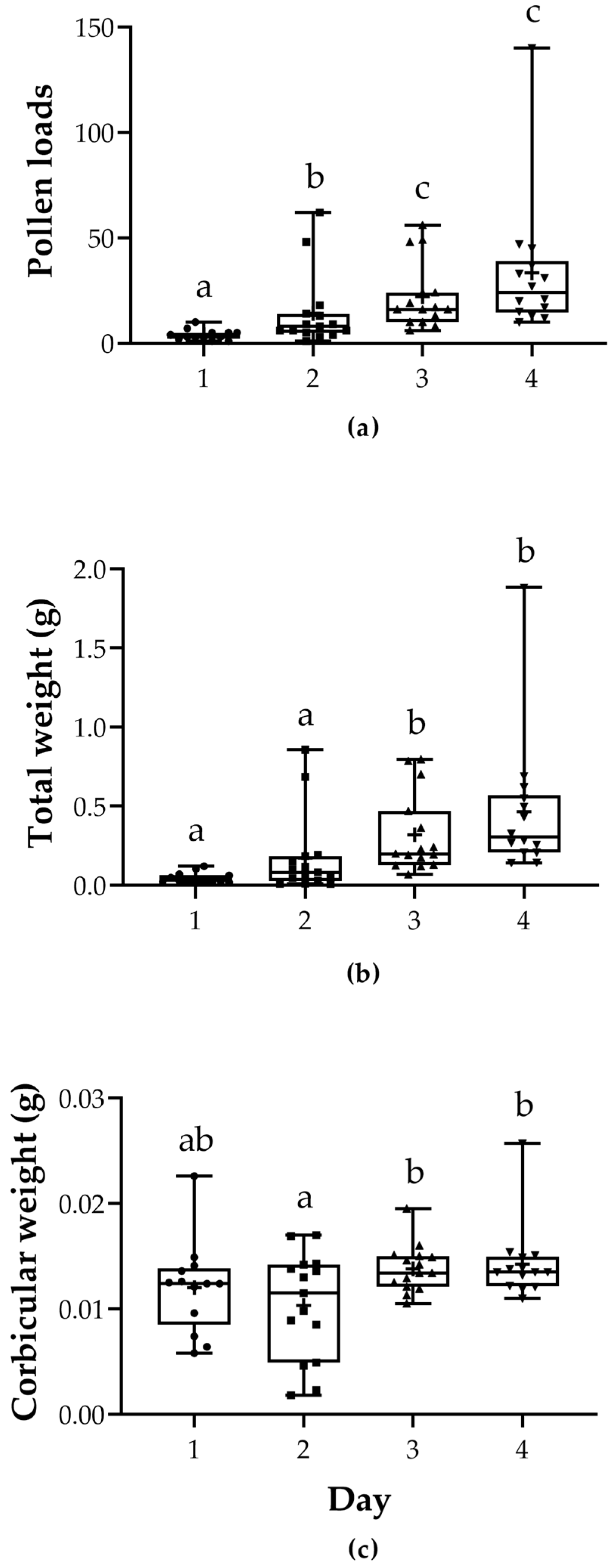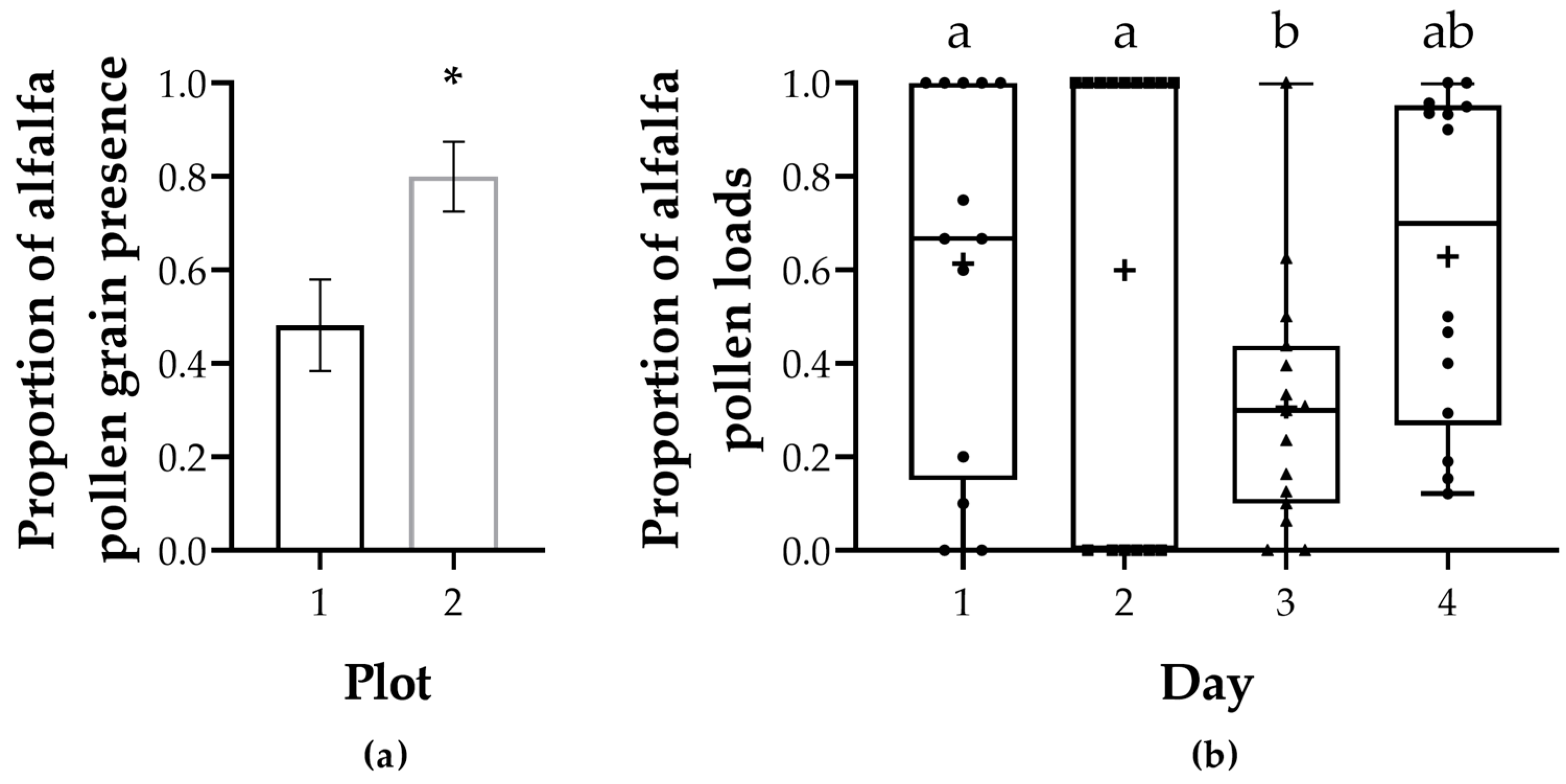The South American Black Bumblebee (Bombus pauloensis) as a Potential Pollinator of Alfalfa (Medicago sativa)
Abstract
1. Introduction
2. Materials and Methods
2.1. Study Site and Managed Bumblebees
2.2. Colony Activity
2.3. Pollinator Density
2.4. Pollen Collection
2.5. Pollen Analysis
2.6. Environmental Variables
2.7. Statistical Analysis
3. Results
3.1. Colony Activity
3.2. Pollinator Density
3.3. Pollen Analysis
4. Discussion
5. Conclusions
Supplementary Materials
Author Contributions
Funding
Institutional Review Board Statement
Data Availability Statement
Acknowledgments
Conflicts of Interest
References
- Roubik, D.W. (Ed.) The Pollination of Cultivated Plants: A Compendium for Practitioners; FAO: Rome, Italy, 2018; Volume 1. [Google Scholar]
- Klein, A.-M.; Vaissière, B.E.; Cane, J.H.; Steffan-Dewenter, I.; Cunningham, S.A.; Kremen, C.; Tscharntke, T. Importance of Pollinators in Changing Landscapes for World Crops. Proc. R. Soc. B 2007, 274, 303–313. [Google Scholar] [CrossRef] [PubMed]
- Potts, S.G.; Biesmeijer, J.C.; Kremen, C.; Neumann, P.; Schweiger, O.; Kunin, W.E. Global Pollinator Declines: Trends, Impacts and Drivers. Trends Ecol. Evol. 2010, 25, 345–353. [Google Scholar] [CrossRef] [PubMed]
- Delaplane, K.S.; Mayer, D.F. Crop Pollination by Bees; CABI Publishing: Oxon, UK, 2000. [Google Scholar] [CrossRef]
- Garibaldi, L.A.; Steffan-Dewenter, I.; Winfree, R.; Aizen, M.A.; Bommarco, R.; Cunningham, S.A.; Kremen, C.; Carvalheiro, L.G.; Harder, L.D.; Afik, O.; et al. Wild Pollinators Enhance Fruit Set of Crops Regardless of Honey Bee Abundance. Science 2013, 339, 1608–1611. [Google Scholar] [CrossRef]
- Isaacs, R.; Williams, N.; Ellis, J.; Pitts-Singer, T.L.; Bommarco, R.; Vaughan, M. Integrated Crop Pollination: Combining Strategies to Ensure Stable and Sustainable Yields of Pollination-Dependent Crops. Basic Appl. Ecol. 2017, 22, 44–60. [Google Scholar] [CrossRef]
- Riday, H.; Reisen, P.; Raasch, J.A.; Santa-Martinez, E.; Brunet, J. Selfing Rate in an Alfalfa Seed Production Field Pollinated with Leafcutter Bees. Crop Sci. 2015, 55, 1087–1095. [Google Scholar] [CrossRef]
- Bohart, G.E. Pollination of Alfalfa and Red Clover. Annu. Rev. Entomol. 1957, 2, 355–380. [Google Scholar] [CrossRef]
- Cane, J.H. Pollinating Bees (Hymenoptera: Apiformes) of U.S. Alfalfa Compared for Rates of Pod and Seed Set. J. Econ. Entomol. 2002, 95, 22–27. [Google Scholar] [CrossRef]
- McGregor, S.E. Insect Pollination of Cultivated Crop Plants; Agricultural Research Service, US Department of Agriculture: Washington, DC, USA, 1976.
- Wang, X.; Liu, H.; Li, X.; Song, Y.; Chen, L.; Jin, L. Correlations between Environmental Factors and Wild Bee Behavior on Alfalfa (Medicago sativa) in Northwestern China. Environ. Entomol. 2009, 38, 1480–1484. [Google Scholar] [CrossRef]
- Reinhardt, J.F. Some Responses of Honey Bees to Alfalfa. Am. Nat. 1952, 86, 257–275. [Google Scholar] [CrossRef]
- Johansen, C. Honey Bees and Alfalfa Seed Production in Eastern Washington; Washington State University Extension: Pullman, WA, USA, 1966.
- Pitts-Singer, T.L.; Cane, J.H. The Alfalfa Leafcutting Bee, Megachile rotundata: The World’s Most Intensively Managed Solitary Bee. Annu. Rev. Entomol. 2011, 56, 221–237. [Google Scholar] [CrossRef]
- Linsley, G.E. Insect Pollinators of Alfalfa in California. J. Econ. Entomol. 1946, 39, 18–29. [Google Scholar] [CrossRef]
- Bohart, G.E. Alfalfa Pollinators with Special Reference to Species Other Than Honey Bees. In Proceedings of the Tenth International Congress of Entomology, Montreal, QC, Canada, 17–25 August 1956; Agricultural Research Service, US Department of Agriculture: Washington, DC, USA, 1958; pp. 929–937. Available online: https://digitalcommons.usu.edu/bee_lab_be/41/ (accessed on 21 October 2024).
- Batra, S.W.T. Comparative Efficiency of Alfalfa Pollination by Nomia melanderi, Megachile rotundata, Anthidium florentinum and Pithitis smaragdula (Hymenoptera: Apoidea). J. Kans. Entomol. Soc. 1976, 49, 18–22. [Google Scholar]
- Tasei, J.N.; Picard, M.; Carre, S. Les Insectes Pollinisateurs De La Luzerne (Medicago sativa L.) en France. Apidologie 1978, 9, 175–194. [Google Scholar] [CrossRef]
- Watmough, R.H. The Potential of Megachile gratiosa Cameron, Xylocopa caffra (Linnaeus) (Hymenoptera: Megachilidae and Anthophoridae) and Other Solitary Bees as Pollinators of Alfalfa, Medicago sativa L. (Fabaceae), in the Oudtshoorn District, South Africa. Afr. Entomol. 1999, 7, 312–315. [Google Scholar]
- Cane, J.H. A Native Ground-Nesting Bee (Nomia melanderi) Sustainably Managed to Pollinate Alfalfa across an Intensively Agricultural Landscape. Apidologie 2008, 39, 315–323. [Google Scholar] [CrossRef]
- Wang, X.; Liu, H.; Huang, L.; Zhang, S.; Deng, Z.; Li, J.; Jin, L. Biodiversity of Wild Alfalfa Pollinators and Their Temporal Foraging Characters in Hexi Corridor, Northwest China. Entomol. Fenn. 2012, 23, 4–12. [Google Scholar] [CrossRef][Green Version]
- Brunet, J.; Stewart, C.M. Impact of Bee Species and Plant Density on Alfalfa Pollination and Potential for Gene Flow. Psyche A J. Entomol. 2010, 2010, 201858. [Google Scholar] [CrossRef]
- Velthuis, H.H.W.; Van Doorn, A. A Century of Advances in Bumblebee Domestication and the Economic and Environmental Aspects of Its Commercialization for Pollination. Apidologie 2006, 37, 421–451. [Google Scholar] [CrossRef]
- Mader, E.; Spivak, M.; Evans, E. Managing Alternative Pollinators: A Handbook for Beekeepers, Growers, and Conservationists; SARE Handbook 11, NRAES-186; SARE: New York, NY, USA; NRAES: Ithaca, NY, USA, 2010. [Google Scholar]
- Riaño, D.; Espinoza, J.P.; Cure, J.R.; Rodriguez, D. Pollination Behavior and Efficiency of Bombus atratus Franklin in Sweet Peppers (Capsicum annum L.) Grown in a Greenhouse Comportamiento y Eficiencia de Polinización de Bombus atratus Franklin En Pimentón (Capsicum annum L.) Sembrado Bajo Invernadero TT. Rev. Colomb. Cienc. Hort. 2015, 9, 259–267. [Google Scholar] [CrossRef]
- Martins, K.T.; Gonzalez, A.; Lechowicz, M.J. Pollination Services Are Mediated by Bee Functional Diversity and Landscape Context. Agric. Ecosyst. Environ. 2015, 200, 12–20. [Google Scholar] [CrossRef]
- Estravis-Barcala, M.C.; Palottini, F.; Macri, I.; Nery, D.; Farina, W.M. Managed Honeybees and South American Bumblebees Exhibit Complementary Foraging Patterns in Highbush Blueberry. Sci. Rep. 2021, 11, 8187. [Google Scholar] [CrossRef] [PubMed]
- Renzi, J.P.; Reinoso, O.; Bruna, M.; Crisanti, P.; Rodríguez, G.; Cantamutto, M.A. Producción de Semillas de Alfalfa (Medicago sativa) y Otras Forrajeras En El Valle Bonaerense Del Río Colorado; EEA: Hilario Ascasubi, Argentina, 2018; Volume 56. [Google Scholar] [CrossRef]
- Basigalup, D.H. Investigación, Producción e Industrialización de La Alfalfa En Argentina; Basigalup, D.H., Ed.; Ediciones INTA: Buenos Aires, Argentina, 2022. [Google Scholar]
- Bosch, J.; Kemp, W.P. Alfalfa Leafcutting Bee Population Dynamics, Flower Availability, and Pollination Rates in Two Oregon Alfalfa Fields. J. Econ. Entomol. 2005, 98, 1077–1086. [Google Scholar] [CrossRef] [PubMed]
- Moschetti, C.J.; Martínez, E.M.; Echeverría, E.M.; Ávalos, L.M. Producción de Semilla de Alfalfa; Basigalup, D.H., Ed.; Ediciones INTA: Buenos Aires, Argentina, 2007; pp. 405–448. [Google Scholar]
- Haedo, J.P.; Martínez, L.C.; Graffigna, S.; Marrero, H.J.; Torretta, J.P. Managed and Wild Bees Contribute to Alfalfa (Medicago sativa) Pollination. Agric. Ecosyst. Environ. 2022, 324, 107711. [Google Scholar] [CrossRef]
- Ochoa, L.H. La Producción de Semilla de Alfalfa En La Provincia de Santiago Del Estero. In Simposio De Producción De Semilla De Alfalfa; IDIA N.° 391–392; INTA: Buenos Aires, Argentina, 1980; pp. 78–87. [Google Scholar]
- Fernandez, M.J.; Ves Losada, J.C.; Naab, O.; Baudino, E.M.; Dreussi, L.W. Himenópteros Polinizadores Asociados al Cultivo de Alfalfa En El Area Del Caldenal de La Provincia de La Pampa; INTA: Anguil, Argentina, 2004. [Google Scholar]
- Haedo, J.P.; Graffigna, S.; Martínez, L.C.; Torretta, J.P.; Marrero, H.J. Estimación Del Servicio de Polinización En Un Cultivo de Alfalfa (Medicago sativa L.) Mediante La Cuantificación de Flores Disparadas. Ecol. Austral 2022, 32, 297–306. [Google Scholar] [CrossRef]
- Basualdo, M.; Messina, N.; Rodríguez, E.M.; Rivadeneira, M.F.M.F. Bombus atratus (Hymenoptera: Apidae) Como Polinizador de Arándanos (Vaccinium corymbosum L.). Hortic. Argent. 2013, 32, 127. [Google Scholar]
- Basualdo, M.; Rodríguez, E.M. Resultados de La Evaluación de La Actividad de Forrajeo de Bombus pauloensis En Tomate; Convenio Brometán–INTA: Tandil, Argentina, 2009. [Google Scholar]
- Cavigliasso, P.; Bello, F.; Rivadeneira, M.F.; Monzon, N.O.; Gennari, G.P.; Basualdo, M. Pollination Efficiency of Managed Bee Species (Apis mellifera and Bombus pauloensis) in Highbush Blueberry (Vaccinium corymbosum) Productivity. J. Hort. Res. 2020, 28, 57–64. [Google Scholar] [CrossRef]
- Salvarrey, S.; Arbulo, N.; Rossi, C.; Santos, E.; Salvarrey, L.; Invernizzi, C. Use of Native Bumblebees (Bombus atratus Franklin and Bombus bellicosus Smith) to Improve Seed Production of Red Clover (Trifolium pratense)./Utilización de Abejorros Nativos (Bombus atratus Franklin y Bombus bellicosus Smith) Para Mejorar La Producción de Trèbol Rojo (Trifolium pratense). Agrociencia 2017, 21, 95–104. [Google Scholar]
- Martínez, E.M.M. Polinización de Alfalfa (Medicago sativa L.) Utilización de Abeja Melífera (Apis mellifera L.); INTA Ediciones-Dirección Nacional Asistente de Comunicación Institucional Gerencia de Contenidos Periodísticos y Editoriales: Hilario Ascasubi, Argentina, 1988. [Google Scholar]
- Vaissière, B.E.; Freitas, B.B.M.; Gemmill-Herren, B. Protocol to Detect and Assess Pollination Deficits in Crops: A Handbook for Its Use; Food and Agriculture Organization of the United nations (FAO): Rome, Italy, 2011; p. 70. [Google Scholar]
- Judd, H.J.; Huntzinger, C.; Ramirez, R.; Strange, J.P. A 3D Printed Pollen Trap for Bumble Bee (Bombus) Hive Entrances. JoVE 2020, 161, e61500. [Google Scholar] [CrossRef]
- Newstrom-Lloyd, L.; Scheele, F.; Raine, I.; Li, X.; Gonzalez, M.; Roper, T. Pollen Pellet Colour, Purity & Identification. Sustainable Farming Fund—Ministry of Agriculture and Forestry: Wellington, New Zealand, 2012. [Google Scholar]
- Conti, I.; Medrzycki, P.; Grillenzoni, F.V.; Corvucci, F.; Tosi, S.; Malagnini, V.; Spinella, M.; Mariotti, M.G. Floral Diversity of Pollen Collected by Honey Bees (Apis mellifera L.)—Validation of the Chromatic Assessment Method. J. Apic. Sci. 2016, 60, 209–220. [Google Scholar] [CrossRef]
- R Core Team. R: A Language and Environment for Statistical Computing; R Foundation for Statistical Computing: Vienna, Austria. Available online: https://www.R-project.org (accessed on 4 July 2024).
- RStudio Team. RStudio: Integrated Development Environment for R. Posit Software; PBC: Boston, MA, USA, 2023; Available online: http://www.rstudio.com/ (accessed on 4 July 2024).
- Brooks, M.; Kristensen, K.; van Benthem, K.; Magnusson, A.; Berg, C.; Nielsen, A.; Skaug, H.; Maechler, M.; Bolker, B. GlmmTMB Balances Speed and Flexibility Among Packages for Zero-Inflated Generalized Linear Mixed Modeling. R J. 2017, 9, 378–400. [Google Scholar] [CrossRef]
- Bates, D.; Mächler, M.; Bolker, B.; Walker, S. Fitting Linear Mixed-Effects Models Using Lme4. J. Stat. Softw. 2015, 67, 1–48. [Google Scholar] [CrossRef]
- Heinrich, B. Bumblebee Economics; Harvard University Press: Cambridge, NY, USA, 2004. [Google Scholar]
- Bohart, G.E.; Nye, W.P.; Levin, M.D. Growing Alfalfa for Seed; Agricultural Experiment Station—Utah State Agricultural College-United States Department of Agriculture: Logan, UT, USA, 1955; Volume 135. [Google Scholar]
- Müller, H. Die Befruchtung der Blumen durch Insekten und die gegenseitigen Anpassungen beider: Ein Beitrag zur Erkenntniss des ursächlichen Zusammenhanges in der organischen Natur (The Fertilization of Flowers by Insects and the Mutual Adaptations of Both: A Contribution to the Understanding of the Causal Relationships in Organic Nature); Engelmann: Leipzig Germany, 1873. [Google Scholar]
- Helmbold, F. Untersuchungen Tiber Die Befruchtungsverhaltnisse, Tiber Die Bedingungen Und Tiber Die Vererbung Der Samenerzeugung Bei Luzerne (Investigations on Fertilization, on the Conditions and Inheritance of Seed Production in Lucerne (Medicago sativa). Zeitsclzrift Für Pflanzenzilclztung 1929, 14, 113–173. [Google Scholar]
- Peck, O.; Bolton, J.L. Alfalfa Seed Production in Northern Saskatchewan as Affected by Bees, with a Report on Means of Increasing the Populations of Native Bees. Sci. Agric. 1946, 26, 388–418. [Google Scholar]
- Jones, L.G. Increased Production of Alfalfa Seed with Honey-Bees Pollination. In North American Alfalfa Improvement Conference; Aamodt, O.S., Ed.; Lethbridge: Alberta, Canada, 1950; pp. 38–40. [Google Scholar]
- Vansell, G.H. Use of Honey Bees in Alfalfa Seed Production; US Department of Agriculture: Washington, DC, USA, 1951.
- Levin, M.D. A Technique for Estimating the Percentage of Honey Bees Visiting Alfalfa. J. Econ. Entomol. 1955, 48, 484–485. [Google Scholar] [CrossRef]
- Levin, M.D. Distribution Patterns of Young and Experienced Honey Bees Foraging on Alfalfa. J. Econ. Entomol. 1959, 52, 969–971. [Google Scholar] [CrossRef]
- Raine, N.E.; Chittka, L. Pollen Foraging: Learning a Complex Motor Skill by Bumblebees (Bombus terrestris). Naturwissenschaften 2007, 94, 459–464. [Google Scholar] [CrossRef] [PubMed]
- Díaz, P.C.; Arenas, A.; Fernández, V.M.; Susic Martin, C.; Basilio, A.M.; Farina, W.M. Honeybee Cognitive Ecology in a Fluctuating Agricultural Setting of Apple and Pear Trees. Behav. Ecol. 2013, 24, 1058–1067. [Google Scholar] [CrossRef]
- Baur, A.; Strange, J.P.; Koch, J.B. Foraging Economics of the Hunt Bumble Bee, a Viable Pollinator for Commercial Agriculture. Environ. Entomol. 2019, 48, 799–806. [Google Scholar] [CrossRef]
- Laverty, T.M.; Plowright, R.C. Flower Handling by Bumblebees: A Comparison of Specialists and Generalists. Anim. Behav. 1988, 36, 733–740. [Google Scholar] [CrossRef]
- Woodward, G.L.; Laverty, T.M. Recall of Flower Handling Skills by Bumble Bees: A Test of Darwin’s Interference Hypothesis. Anim. Behav. 1992, 44, 1045–1051. [Google Scholar] [CrossRef]
- Urbaneja-Bernat, P.; Cloonan, K.; Zhang, A.; Salazar-Mendoza, P.; Rodriguez-Saona, C. Fruit volatiles mediate differential attraction of Drosophila suzukii to wild and cultivated blueberries. J. Pest Sci. 2021, 94, 1249–1263. [Google Scholar] [CrossRef]
- Rodriguez-Saona, C.; Parra, L.; Quiroz, A.; Isaacs, R. Variation in highbush blueberry floral volatile profiles as a function of pollination status, cultivar, time of day and flower part: Implications for flower visitation by bees. Ann. Bot. 2011, 107, 1377–1390. [Google Scholar] [CrossRef]
- Liu, J.; Zhang, J.; Shen, J.; Zhao, H.; Ma, W.; Jiang, Y. Differences in EAG Response and Behavioral Choices between Honey Bee and Bumble Bee to Tomato Flower Volatiles. Insects 2022, 13, 987. [Google Scholar] [CrossRef] [PubMed]
- Mänd, M.; Maavara, V.; Martin, A.J.; Mänd, R. The Density of Bombus lucorum (L.) Required to Effect Maximum Pollination of Alfalfa in Estonia. J. Apic. Sci. 1996, 35, 79–81. [Google Scholar] [CrossRef]
- Palottini, F.; Estravis-Barcala, M.C.; Farina, W.M. Odor learning in classical conditioning of proboscis extension in the South American native bumblebee Bombus atratus (Hymenoptera: Apidae). Front. Psychol. 2018, 9, 603. [Google Scholar] [CrossRef]
- Nery, D.; Palottini, F.; Farina, W.M. Classical olfactory conditioning promotes long term memory and improves odor-cued flight orientation in the South American native bumblebee Bombus pauloensis. Curr. Zool. 2020, 67, 561–563. [Google Scholar] [CrossRef] [PubMed]
- Farina, W.M.; Arenas, A.; Estravis-Barcala, M.C.; Palottini, F. Targeted crop pollination by training honey bees: Advances and perspectives. Front. Bee Sci. 2023, 1, 1253157. [Google Scholar] [CrossRef]




Disclaimer/Publisher’s Note: The statements, opinions and data contained in all publications are solely those of the individual author(s) and contributor(s) and not of MDPI and/or the editor(s). MDPI and/or the editor(s) disclaim responsibility for any injury to people or property resulting from any ideas, methods, instructions or products referred to in the content. |
© 2024 by the authors. Licensee MDPI, Basel, Switzerland. This article is an open access article distributed under the terms and conditions of the Creative Commons Attribution (CC BY) license (https://creativecommons.org/licenses/by/4.0/).
Share and Cite
Nery, D.; Palottini, F.; Farina, W.M. The South American Black Bumblebee (Bombus pauloensis) as a Potential Pollinator of Alfalfa (Medicago sativa). Agriculture 2024, 14, 2192. https://doi.org/10.3390/agriculture14122192
Nery D, Palottini F, Farina WM. The South American Black Bumblebee (Bombus pauloensis) as a Potential Pollinator of Alfalfa (Medicago sativa). Agriculture. 2024; 14(12):2192. https://doi.org/10.3390/agriculture14122192
Chicago/Turabian StyleNery, Denise, Florencia Palottini, and Walter M. Farina. 2024. "The South American Black Bumblebee (Bombus pauloensis) as a Potential Pollinator of Alfalfa (Medicago sativa)" Agriculture 14, no. 12: 2192. https://doi.org/10.3390/agriculture14122192
APA StyleNery, D., Palottini, F., & Farina, W. M. (2024). The South American Black Bumblebee (Bombus pauloensis) as a Potential Pollinator of Alfalfa (Medicago sativa). Agriculture, 14(12), 2192. https://doi.org/10.3390/agriculture14122192







